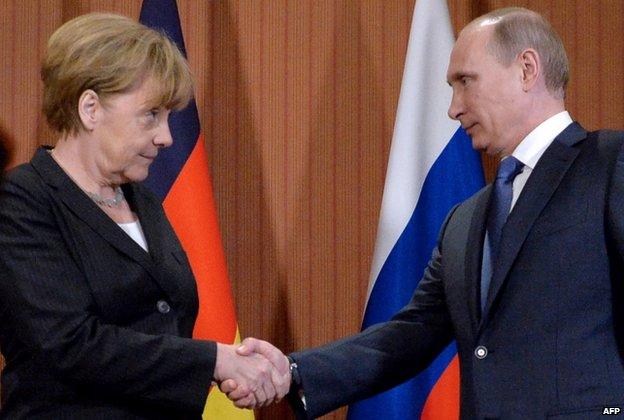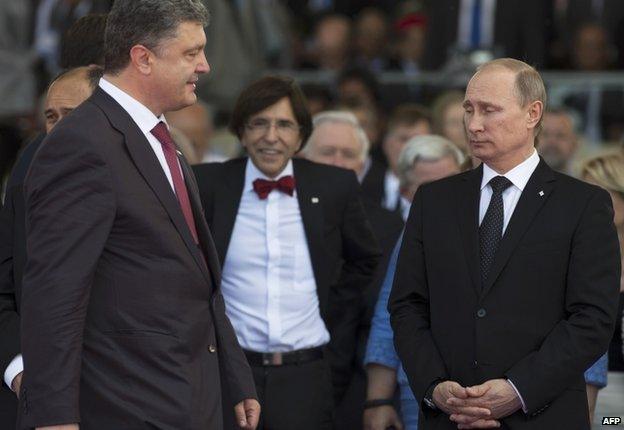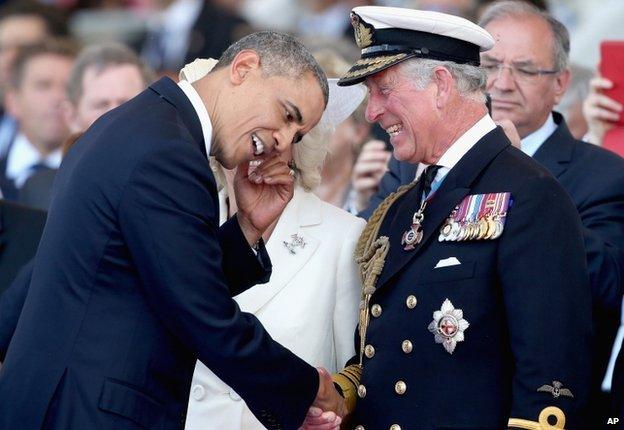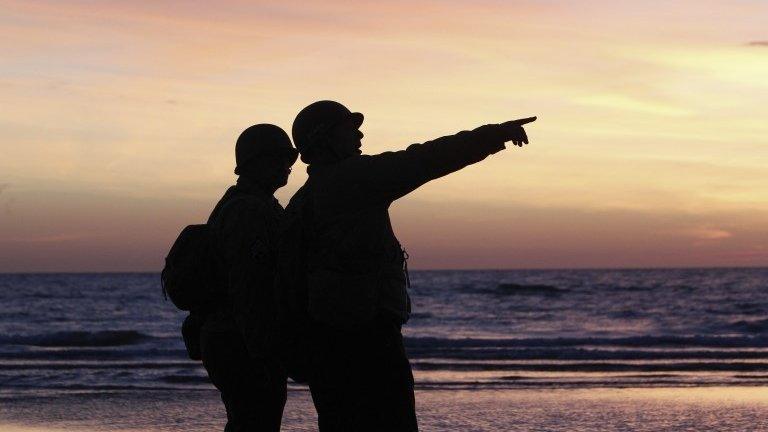D-Day anniversary: What does leaders' body language show?
- Published
The meeting came as fighting continued in eastern Ukraine
World leaders have come together at Ouistreham in northern France to commemorate the 70th anniversary of the D-Day landings.
The day provided some unusual exchanges for those coming face-to-face. What could the body language tell us about relationships?

The handshake
Amid high tensions over Russia's role in the Ukraine crisis, German Chancellor Angela Merkel was one of the first Western leaders to allow President Vladimir Putin back into the diplomatic fold, with a meeting at a hotel before Friday's main events.
But she still seemed to be holding him at arm's length.
"This is the coldest handshake we have ever seen from Angela Merkel," says Joe Navarro, a body language expert who spent 25 years using his expertise to catch spies for the FBI.

"With that chin down she is visually castigating Mr Putin who seems strained, stiff, and very uncomfortable."
"Ms Merkel traditionally has quite a tactile relationship with other world leaders, involving informal greeting rituals like hugging, cheek-kissing or forms of mock-fighting," says behaviour expert Judi James. "This handshake with Mr Putin takes a more formal ritual and places it on an icy basis."
The pair appear to be standing as far apart as possible, she adds, and while the hand clasp looks firm, it is "more of a display of strength than an open and trusting meeting of palm against palm".
"Mr Putin's facial expression looks faintly wary as though he's not quite sure what to expect but Merkel is giving it to him with both barrels," says Ms James.
"The raised browed stare implies an almost school teacher-ish level of disapproval."

The group photo
Posing for a group photograph can be awkward for the best of us.
When leaders including US President Barack Obama, New Zealand's Governor General Jerry Mateparae, and President Putin gathered for a picture, they handled the situation with differing approaches.

"By standing to one side and seemingly choosing to ignore the Queen [Elizabeth] - rather than offer assistance as President Obama is doing - Mr Putin might just be showing a knowledge of royal etiquette," says behaviour expert Ms James.
Several other world leaders, such as Australia's former prime minister, external, have been mocked in the press in previous years for failing to understand the "hands off" rule that applies to UK monarchs.
"President Putin's distant gaze does look a little odd, though, in a scenario where perhaps a look or smile of concern could be appropriate. Overall he appears isolated from the action, like the kid in the playground that nobody currently likes," says Ms James.
"Mr Obama's response is very human and his concern genuine. Even Angela Merkel gazes from a conversation a few steps up with a look of empathy."
Mr Navarro also says the picture speaks of Mr Putin's isolation while the Western powers seem bound together.

Standing tall
President Putin spoke for the first time to Ukraine's President-elect, Petro Poroshenko, on the sidelines of the commemorations.
It came amid calls for Russia to recognise Mr Poroshenko as Ukraine's new leader.

"Putin seems to have closed down here, with three key cut-off gestures: the narrowed eyes, the pulled-in lips and the joined thumbs," says Ms James, adding that he appears to be waiting for the action to come to him.
"He seems to have got his way in this as Mr Poroshenko's pose suggests he's trying to get some sort of greeting or acknowledgment going."
Mr Navarro says the image "speaks volumes" about the two leaders' relationship.
"President Putin is looking at the new Ukrainian president with disdain and indifference," he says. "That closed off look, avoiding eye contact, communicates how unimportant Mr Poroshenko is to him.
"One has to admire Mr Poroshenko for standing tall and smiling."

Reasons to be cheerful
"Humour is one of the most powerful bonding agents," says Ms James.
President Obama certainly seems to be making the Prince of Wales chuckle in this photograph, leading some observers to believe they get on well.
"They have a wonderful relationship," says Mr Navarro. "Those are true, genuine smiles - the kind that make us bend with laughter. Whatever was said is no doubt funny."

Ms James agrees that the amusement appears sincere.
"It looks like Mr Obama is supplying the punch line here as he seems to be pointing to his own head to get the laugh, while Prince Charles' teeth-baring, eye-crinkling response suggests he's genuinely tickled," she says.
"The fact that this joke was shared during the actual shaking of hands is even more remarkable. The ritual is normally so swift there's barely enough time for more than a spoken introduction."
- Published5 June 2014
